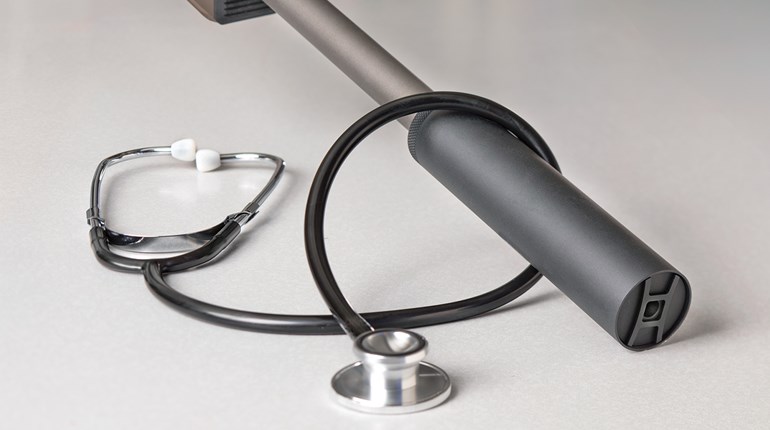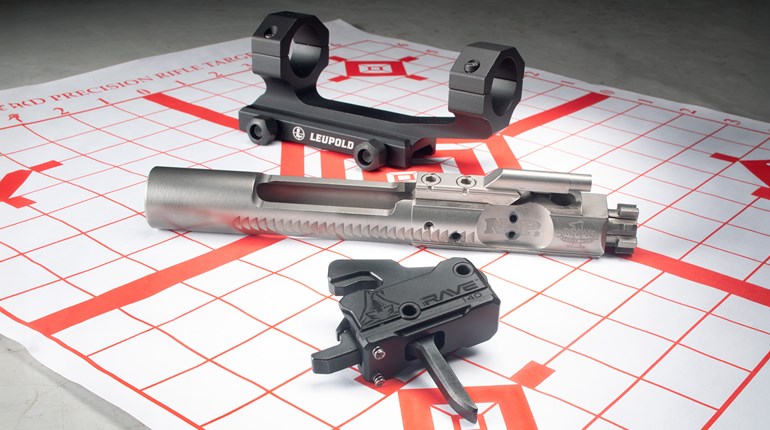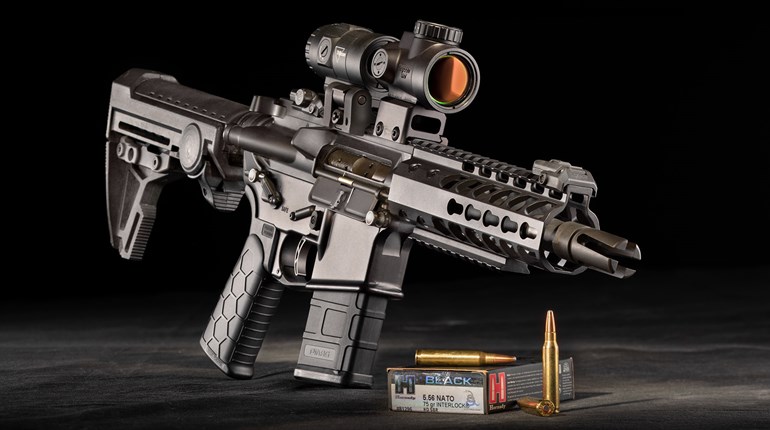
Modern rifle scope reticle designs provide information for ranging, target-size estimation and points to hold for both windage and elevation offset. From left to right: Tract Toric ELR MRAD, Bushnell Deploy MIL, Leupold PR2-MIL, Horus TREMOR3.
Special-purpose rifle scope reticles are not exactly a new invention. For example, the common duplex-reticle-based, mil-dot design has been around since the 1970s. Ballistic Drop Compensating (BDC) configurations are much older than that. However, modern optics with reticles that feature extensive aiming grids and ranging scales are direct descendants of Horus Vision’s hunting-scope reticles.
My introduction to Horus products came in 2002, when professional shooter Bennie Cooley loaned an early Horus hunting scope to my sniper teammate and good friend, John “Shrek” McPhee. Shrek studied the reticle system and shared his findings with the rest of our team. We were quickly sold on the concept and began convincing most of our unit’s snipers, followed by the larger SOF sniping community, that managing elevation and windage changes with an advanced reticle was far more effective than doing so with scope knobs and crude (by comparison) mil-dots. The impact that Horus Vision’s system had on long-range sniping was monumental and in the two decades since, similar precision rifle scope reticles have evolved significantly and proliferated widely.
When placed in a variable-power scope’s first focal-plane (FFP), a reticle’s size remains relative to the image size, regardless of magnification. Therefore, calibrated markings may be used at any power at which the eye can still discern them. Conversely, the relationship between reticle and image sizes changes with magnification settings in second-focal-plane (SFP) riflescopes. Therefore, one must use maximum-power settings, or apply some quick math, in order to use SFP reticle aiming points. When maximum magnification is a hindrance—such as in low light or when a larger field-of-view is required—FFP reticle placement is particularly useful.
I cut my teeth on sniper optics with mil-dot reticles and minute-of-angle (MOA) elevation and windage knobs back in the 1990s. Then, as now, military personnel blend standard and metric measurements, depending on the application. When it comes to sniping, each service has its own ideas about when to use mils and when to use MOA, but nowadays, most tactical long-range work is done with mil-based reticles and mil-graduated scope knobs. Rifle shooters usually find this setup much easier to work with once they get away from scopes with MOA knobs and mil-based reticles. Even so, riflescopes with MOA knobs and reticles are still popular in some forms of competition, hunting and target shooting. Fortunately, advanced MOA-reticle options can also be found for rifle shooters who are more comfortable working in inches.
Horus Vision’s old workhorse H25 was an effective, basic reticle. But, its later designs, such as the trimmed-down H27 and my personal favorite, the H59, have far greater utility. The TREMOR series of reticles, such as the TREMOR3 in current use by USSOCOM, are extremely popular in both military and long-range competitive circles.
Tract’s MRAD ELR and MOA ELR rifle stope reticles—found in select models of its Toric scopes—provide ample elevation and windage references for long-range use. Likewise, Bushnell’s G2, G3 and Deploy-MIL reticles share the now-common “Christmas tree” design, but with that company’s own spin. I have put tens of thousands of well-aimed rounds through riflescopes with both the Tract MRAD ELR and the Bushnell G2 reticles, so I can vouch for the efficacy of their layouts.
US Optics has offered long range reticle-equipped scopes for many years. Current options include the H425, H59, H102, TREMOR3 and the company’s own JVCR reticle. While Nightforce was slow getting to the FFP party, it currently offers H59 and TREMOR3 reticles, as well as its own FC-DM, FC-DMx and MIL-XT designs.
Leupold has an extensive roster of options in its current lineup. In addition to H27, H59, TREMOR2 and TREMOR3 reticles, the company features offers the Impact 60-MOA reticle for standard measurement aficionados. I recently got a look at the Leupold’s latest advanced reticle offering, the PR2-MIL, in its excellent MK5 HD 5-25x56 mm scope.
I found it to be a vast improvement over Leupold’s previous in-house designs. In addition to the space around a floating, .05-mil center dot, each point where a full-, half- or quarter-mil mark intersects the horizontal and vertical stadia is left open. The resulting dashed line appearance provides regular apertures at each of the mil markings, through which one can aim at tiny targets. At 6X, my aging eyes could resolve 26 mils below the reticle’s center. At 25X, approximately 6.5 mils were visible. Two mils are provided for use above the reticle’s center as well. The MK5’s .1-mil-graduated elevation knobs provide 34.9 mils of adjustment in the 5-25X model. While the bulk of the PR2-MIL reticle subtends to .25 mil, each stadia has a 1-mil-long segment that is divided into .1-mil increments for more detailed target measuring and ranging calculations.
Like many of the earlier advanced rifle scope reticles, when the scope is adjusted to its lowest power, the reticle forms a faint arrow which can be used to acquire targets relatively quickly, with practice. As has been common since advanced reticles were first tailored for military use, every other mil line below center is numbered (even, in this case) on opposing ends. This marking method reduces reticle clutter, while still providing peripheral indicators of even- or odd-numbered mil lines.
In spite of ample mil holds along the vertical stadia, the wind grid only extends to 10 mils below center. My brief testing of the PR2-MIL reticle revealed that it makes easy work of hitting tiny targets. I used multiple rifles with match and target loads at modest distances and without any trouble. Overall, the PR2-MIL is a good addition to the growing field of advanced, long range reticles and definitely worth a look.




































